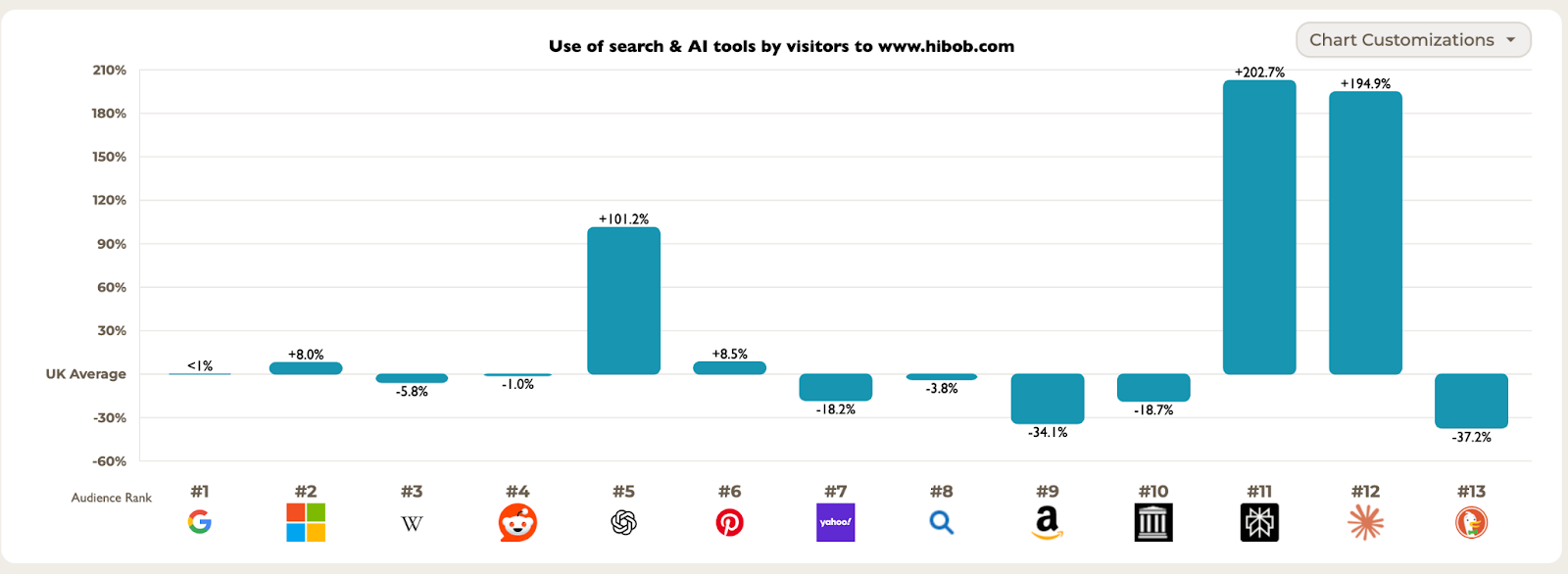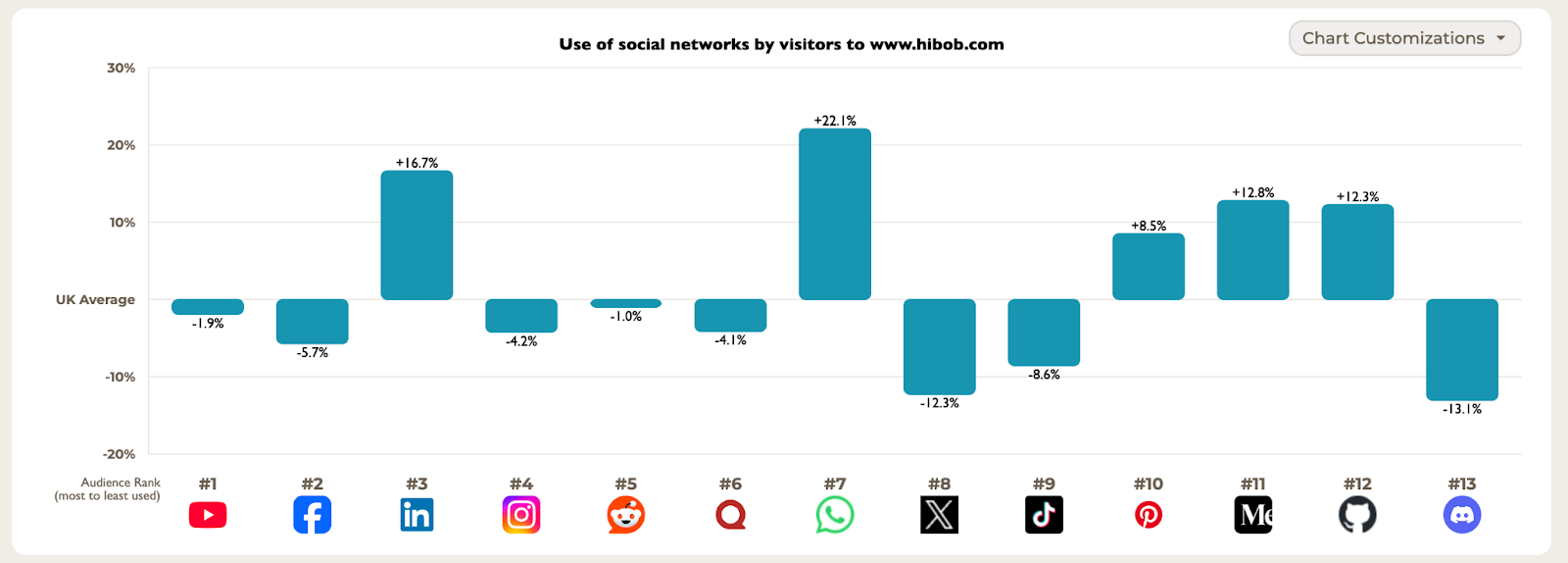
Total Search Optimisation: Connect With Your Audience Where it Counts
Published August 13, 2025
Radina Ivanova joins us this week to explain ‘Total Search Optimisation’ and its importance in the era of AI search.
“Google market share drops below 90% for the first time since 2015.”
This is what Search Engine Land reported in January earlier this year. For me, the only surprising thing from this report is that it’s taken so long for Google’s position to drop after the introduction of ChatGPT in November 2022. I would argue that, when it comes to search engines, Google is still the platform that provides the best experience—if we compare Google to Bing, Yandex or Baidu. However, the definition of a ‘search engine’ has changed and so has the way we search.
Gone are the days people would Google a question or look for a service, read through 10 blue links, visit page two of Google when they felt adventurous, only to spend up to an hour scanning through well-optimised articles that essentially regurgitate the same information. OpenAI changed the game with their launch of ChatGPT, and Google is attempting to mimic this experience with the launch of AI Mode. AI platforms are the answer engine Google has strived to be for so long.
With this unique experience come unique challenges for marketers of course, and organic specialists in particular. How do we appear in LLMs when our customers are searching and how do we measure performance when traffic is no longer a reliable metric? How do we drive value and contribute to the bottom line when people can find most of what they need without clicking through to a site? How do we prove the benefit of unique content creation if an AI platform scrapes it and uses it for training purposes?
Well, I don’t have all the answers but I do know people are still searching, they are just searching in a different way and Total Search Optimisation is one of the answers.
Contents:
The search landscape
Some may say that LLMs are only used for top of the funnel, informational content, influencing the initial research phase of the customer journey. That’s not the case; we are witnessing a growth in conversions occurring directly within these new search engines for our clients at Hallam. Whether it’s lead gen or revenue, people are converting when searching for a solution on ChatGPT or Perplexity.
Alongside these new search engines, your audience is also on social media platforms and forums like Reddit and Quora. They consume different types of content, on different platforms, at different times of the day.
Consider Google’s Messy Middle study that came out in 2020. Even then, customers didn’t follow a linear search behaviour to arrive at your site and purchase a product. Five years on and we have access to more platforms that offer considerably different search experiences, where every interaction with your brand can make a difference. Consumer behaviour online is non-linear and transcends one search engine and one social media platform. Your Organic Search strategy should reflect this.
What is Total Search Optimisation?
Total Search Optimisation is a holistic approach that goes beyond Search Engine Optimisation and aims to increase brands’ visibility across all the platforms that matter for their audience. It encompasses a user centric approach, with traditional search and paid and organic collaboration.
User centric approach
For years, Organic Search focused on Google, and with good reason. Today, however, people turn to other platforms for discovery. For instance, Gen Z use social media for product discovery, Reddit has seen significant growth and your customers are finding you through AI responses.
Tools like SparkToro can give us audience data based on the different search and AI platforms they use, as well as preferred social media platforms. Here is an example of the data we have access to for an HR platform called HiBob.

We can quickly see that the visitors to this website have a very high affinity for AI platforms with Perplexity leading the way at 200% above the UK average. You can guess what comes next: testing Perplexity answers and monitoring referral traffic from this AI platform.
Perplexity in particular is excellent at providing top sources and citations, and you need to ensure your business is listed on these platforms so that it can appear in the responses.
Next, we can see the audience affinity towards social media platforms. LinkedIn is not a surprise as it’s the perfect place for sharing thought leadership content, driving brand awareness and soft conversions.
Reddit is another hidden gem. It has been one of my favourite platforms for customer research lately. If you think Reddit is only for B2C, think again. A lot of B2B buyers are on the platform discussing issues and asking for advice. In fact, I run a customer research based on the most popular topics on Reddit and at the same time my client asked me to work on keyword research for a topic I had just discovered on Reddit. I’m certain the sentiment here is clear. Research where your audience spends time and optimise for that content type and platform accordingly.

Ranking in AI Overviews and LLMs
Being listed in the AI responses is no doubt rooted in good SEO practices. Technical SEO still plays a huge part in discoverability and your EEAT signals will play a more important role in Gemini and AIOs (powered by Gemini), than perhaps Perplexity.
ChatGPT, however, may rely more heavily on brand mentions and links, which is why Digital PR should already be part of your marketing strategy. In fact, a recent study by Ahrefs showed that brand mentions, brand anchor text, and brand search volume are the top three factors for ranking in Google’s AI Overviews.
Editor’s Note: We discussed the role of brand building in the era of AI search in June’s webinar. ICYMI, the recording is now available!
So, what can you do to appear on these platforms? If you haven’t done Organic Search before, start there; and if you have, take it to the next level and understand how much of your traffic is coming from AI platforms. Research your top terms and see how many times you are appearing as opposed to your competitors. Use tools like Waikay to see what AI tools know about your business and what gaps you need to fill in.
Tracking performance in LLMs
Up until now, tracking organic performance, especially on Google has been relatively easy. We’ve been able to monitor keyword rankings, clicks, CTR, and impressions from our content.
Forecasting was also relatively simple. Whether you take average CTR from your search console account or you use Advanced Web Ranking averages, by knowing average search volume and the potential ranking spot for your content, we could confidently forecast organic traffic and conversion uplifts.
Things are a bit different with LLMs and, currently, there is a lot of data we don’t have access to and, whilst many things are unknown, one thing is for certain: traffic is no longer a reliable metric for performance. LLMs rarely provide citations and when they do, traffic is still very low.
At Hallam, we are able to track traffic from AIOs and monitor AI referral traffic and conversions and we can take things further with Share of Model. Share of model is a measurement of how many times your brand appears in AI responses in comparison to competitors in a particular dataset. It is the equivalent of Share of Search and it’s a metric we use to measure performance in AI search.
Unified Search: Bringing PPC and SEO together
You might already be collaborating with your paid media team and if not, it’s time to start. Organic Search is changing and Paid Search is becoming more expensive, there is no better time than the present to begin sharing data and build strategies between the two specialisms. Here are a few ways you and your team can win with unified search:
- Organic keywords that are performing well: Look at ranking position, traffic and conversions. If you are ranking in position one and are featured in AIO, can you pull paid media budgets and reinvest it in categories that need it most. Monitor traffic and understand if organic traffic and conversions increased.
- Paid keywords that are performing well: Analyse top converting keywords from paid campaigns on Google and Bing. Where is the site ranking organically for these terms?
- Reduce brand spend: Some paid media campaigns focus on brand a lot. Most often than not, your brand is already rankin g in position one f or the brand name, so unless you have a competitor bidding on your brand name, you might be better off reinvesting this budget elsewhere.
- Test keywords: If there is a cluster of keywords that you want to invest time and budget in, see if a paid campaign can be built and see if they convert.
These examples may appear intuitive but at times it’s the simple things that can make the biggest difference. You can of course take your organic and paid media collaboration further.
If you are leading a B2B marketing team and working on an ABM strategy, work with both teams to understand what content is required and how it can be distributed across different platforms.
You can also work with the paid media specialists and amplify thought leadership pieces that have been informed by platform and audience research. Using the data above, you can create content and promote it on said platform.
If I refer you back to my Reddit example, I would have been advising my client to create content on the topics found on Reddit and use paid media to promote it to their target audience as it might have been too early to expect organic traffic to do the heavy lifting.
What is the purpose of your site in this new ecosystem?
If you are still reading this, you might be wondering, what is the purpose of my website in this new ecosystem? This is the right question to ask. In an environment where customers get information without the need to visit a site, where B2C audiences can check out directly from social media platforms using community based solutions like Stan Store, and where attribution will become very difficult, you should be asking questions.
My personal opinion and that of Hallam is that websites will become places of information that search engines and AI platforms use to discover and learn about your brand. As far as Organic Search goes, as long as there are places to search for information, there will be a form of website optimisation and content creation. We are going through a seismic shift and your organic strategy needs to evolve with your customers.
The path forward
When everything is so uncertain, it’s only natural to feel overwhelmed. With this in mind, I want to leave you with a few certainties that I rely on when I look at performance and think ahead.
- Traffic is no longer a reliable metric for success: Traffic is going to decline but the traffic that your site receives should be of higher intent because the customer would have completed their top of the funnel research on the SERP or AI platforms.
- Rankings still matter: At this moment in time, rankings on Google still matter. Yes, CTR is declining, but in order to appear in AIOs, you still need to be ranking well organically.
- Keep your website and content fresh: Your website still needs to be up to date because Google and AI platforms will use it to get information about your business.
- Conversational optimisation: Think about your content in a conversational way. AI platforms are designed to be conversational. When you are creating content, consider what your audience will be searching for next, what follow up questions will they ask? Weave these insights into your content.
- Get as close as possible to your first party data: Customer details, content touchpoints, CRM data, soft conversions, GSC and GA4.
- Focus on your audience and create content that matters to them: As always with Organic Search, create content with the right intent for your audience.
The future of search is conversational, diverse, and deeply integrated with user intent across a multitude of platforms. By embracing Total Search Optimisation, you're not just adapting to these changes; you're actively positioning your brand to thrive wherever your audience chooses to search.

Sitebulb is a proud partner of Women in Tech SEO! This author is part of the WTS community. Discover all our Women in Tech SEO articles.

Radina Ivanova is Organic Search Lead at Hallam. She has over eight years of experience in the SEO industry and loves Technical SEO, Data and Strategy. Her expertise spans working with e-commerce brands and lead generation websites, always delivering value and driving commercial results.
Articles for every stage in your SEO journey. Jump on board.
Related Articles
 Webinar: Brand Visibility - Optimizing for AI Citations
Webinar: Brand Visibility - Optimizing for AI Citations
 Speed-to-Meaning: Technical & Measurement Blueprint for AI Search
Speed-to-Meaning: Technical & Measurement Blueprint for AI Search
 How to Stay Relevant in a World of AI Overviews & Query-Fans
How to Stay Relevant in a World of AI Overviews & Query-Fans
 Sitebulb Desktop
Sitebulb Desktop
Find, fix and communicate technical issues with easy visuals, in-depth insights, & prioritized recommendations across 300+ SEO issues.
- Ideal for SEO professionals, consultants & marketing agencies.
Try our fully featured 14 day trial. No credit card required.
Try Sitebulb for free Sitebulb Cloud
Sitebulb Cloud
Get all the capability of Sitebulb Desktop, accessible via your web browser. Crawl at scale without project, crawl credit, or machine limits.
- Perfect for collaboration, remote teams & extreme scale.
If you’re using another cloud crawler, you will definitely save money with Sitebulb.
Explore Sitebulb Cloud Radina Ivanova
Radina Ivanova

